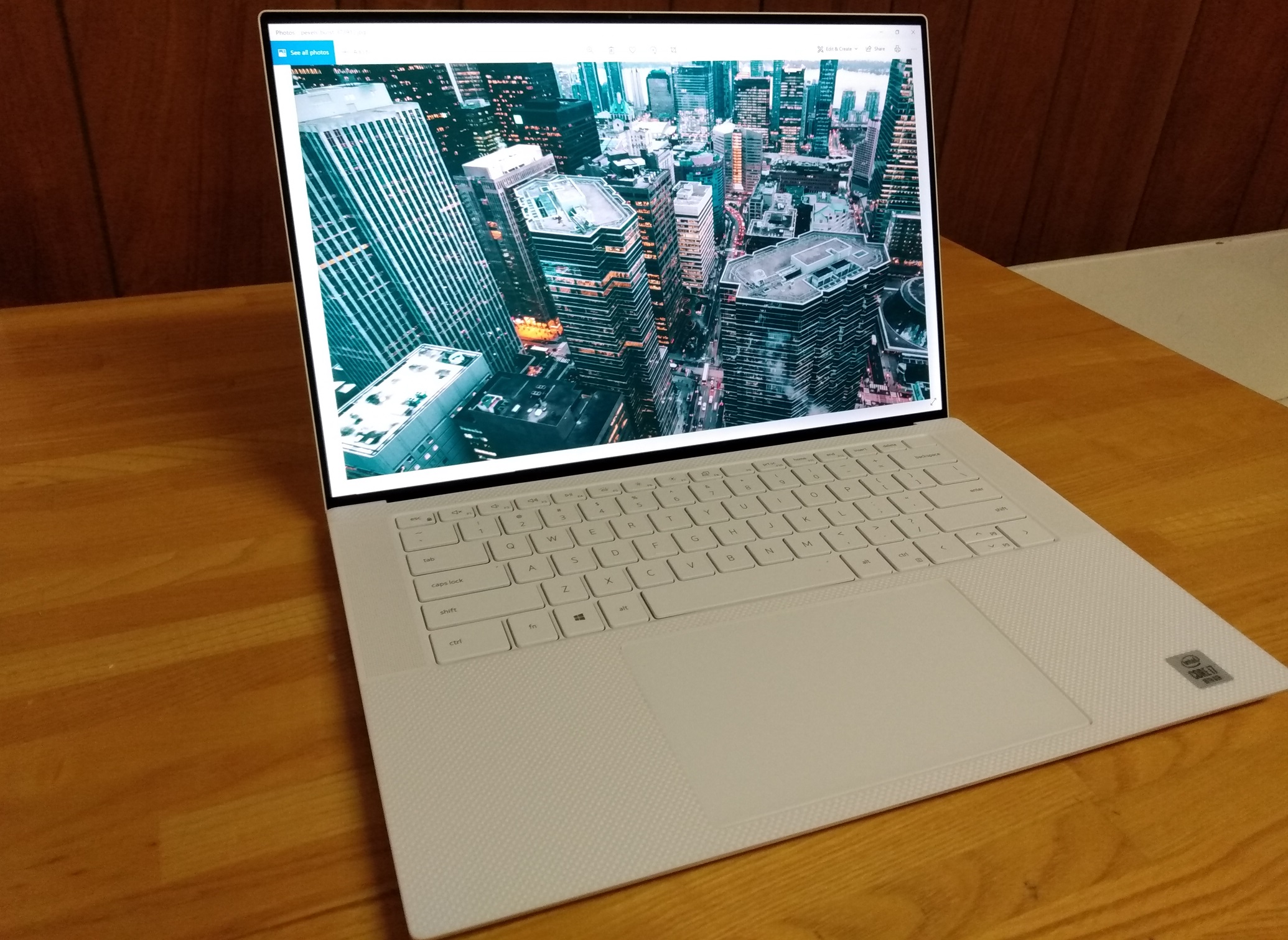 The Dell XPS 15.6-inch Touchscreen Laptop is designed for digital creativity. If you are a graphic designer, a multimedia producer, or any of the other creative pursuits that requires high powered computer capacity in a visually pleasing package, Dell wants you to consider this laptop as your solution. So I put on my digital creative costume and took the Dell XPS Touchscreen for a test drive.
The Dell XPS 15.6-inch Touchscreen Laptop is designed for digital creativity. If you are a graphic designer, a multimedia producer, or any of the other creative pursuits that requires high powered computer capacity in a visually pleasing package, Dell wants you to consider this laptop as your solution. So I put on my digital creative costume and took the Dell XPS Touchscreen for a test drive.
Unboxing
Dell wants you to know how fancy this laptop from the first moment you look at the box. The clean white box is sturdy and without any distracting text or markings, because the laptop is the star of the show. And when you open the box up, you see the laptop exclusively. You’ll find the power supply and connection adapter are tucked below the laptop and revealed when you remove the computer.

Dell XPS Touchscreen Initial Set Up
I hit one issue when I went to set the Dell XPS 15 up: I couldn’t find the power button. Eventually I realized the unlabeled button at the top right of the keyboard wasn’t a delete key, it was the missing button. And it turns out, the power button is also where the fingerprint reader is. The amazing things you learn when you actually read the documentation. After that display of my cunning genius, everything else went smoothly. Set up was quick and painless. I decided to try the face recognition option for signing in, and it is effective.
First impressions
Dell XPS Touchscreen key specs (as tested):
|
This piece of technology is heavier than I expected for a laptop of its size. I should have anticipated that a touchscreen laptop with a durable glass display would have more weight than one with a plastic screen. Once my feeble hands grew accustomed to the 5lb weight, it wasn’t noticeable. I loved the look of the laptop and the responsiveness of the hardware.
Dell XPS touchscreen display
I’ll leave the touchscreen aspect of the display for the next section. As a 4K UHD+ device, the Dell XPS Touchscreen display has a maximum resolution of 3840 x 2400 pixels. It is also a 500-nit display. What’s a nit? That’s a good question that I had to ask as well. A nit is a unit of luminescence, used to measure brightness of a display. And 500 is very bright. Combined with the anti-reflective coating on the screen itself, this makes the display more visible in brightly lit rooms or outside. I thoroughly enjoyed the quality and brightness of the display, in my dimly lit home office and in my sunny back yard.
Touchscreen
The touchscreen is made of Corning Gorilla Glass, a durable glass designed to withstand the grubby accident-prone fingers of humans like me. This was my first go at using a touchscreen laptop, and there was a learning curve. I had a few moments of indecision, with my finger hovering halfway between the immense trackpad and the screen. This is entirely my lack of experience. Once I became more familiar with the option, the touchscreen was easy to use and extremely handy.

Video card
I was relieved to find that the Dell XPS had a discrete video card. A laptop with an integrated video card often struggles to perform well when displaying high resolution graphics. And no, I’m not just talking about video games. Mostly, yes, but not exclusively. The NVIDIA® GeForce® GTX 1650 Ti 4GB GDDR6 is a powerful video card that handled every task that I threw at it without flinching. You get the full effect of the 4K UHD display.
Network capabilities
I was surprised to realize that the Dell XPS Touchscreen did not have an Ethernet port. As an old school nerd, I like to use a wired connection to do operating system updates and other large downloads. However, that isn’t an option here. The move towards minimal ports continues, I suppose. The good news is the Wi-Fi connection was strong and fast. The Dell XPS 15 uses Wi-Fi 6, which is specifically designed to improve your Wi-Fi connection in a multi-device network. And since my home, like yours, is full of things connected to the internet, this technology is greatly appreciated.
Solid state hard drive
You need to make me a promise, that every computer you buy from this point on will have a solid state drive (SSD) as its hard drive. The speed, oh the glorious speed. The Dell XPS Touchscreen that I tested has a 512GB SSD, which is more than ample. The larger 17″ Dell XPS Touchscreen has twice the SSD space with a 1TB drive. If you work with massive digital files and refused to archive them, you might run out of room. But anyone who works in digital media is already well aware of the need for external storage for their archive needs, so this won’t be an issue.
Processor/RAM
You want power? You got it. The Dell XPS Touchscreen comes with 2.6GHz 10th-generation Intel Core i7-10750H hexa-core processor, a CPU that is among the most powerful available for laptops. You can even overclock it to run at 5.0GHz, if you like to push the envelope. I left the overclocking alone, since the Dell XPS easily handled the video editing and compiling I did to test it out. And I have to give credit to the 16GB of DDR4 RAM as well. A fast CPU is meaningless if your computer is starving for available RAM, and the Dell XPS Touchscreen is full of delicious RAM. Is it enough RAM to finally sate Google Chrome’s appetite? Only time will tell.

Connection ports
As I mentioned back in the network section, there’s no Ethernet port on the Dell XPS. In fact, there are only two Thunderbolt 3 ports, one USB 3.1 port, along with an audio port. And a dongle comes with the laptop, to add an older USB 2.0 Type-A, and an HDMI port in place of one of those USB 3.0 ports. If you don’t have a lot of USB peripherals, or have already upgraded to Thunderbolt 3 devices, then the ports will work well with your set up. And as a bonus, the USB 3.1 port has Power Delivery, a technology that would let your Dell XPS Touchscreen power another connected laptop. The Dell XPS Touchscreen also has an SD card reader to facilitate moving data from other devices like a camera.
Dell XPS touchscreen review final thoughts
The Dell XPS 15.6-inch Touchscreen promised to be a laptop that could match the power of a desktop, and it delivers. I’m not a digital content creator normally, but even my casual video and photo editing greatly benefited from this hardware. The display is stunning, and the touchscreen is amazingly responsive. On the down side, the Thunderbolt 3 and USB 3.1 ports mean that your older peripherals won’t connect to the laptop without using adapters. But anyone looking to use this laptop professionally most likely already owns a higher quality external monitor and up to date peripherals that take advantage of the impressive data transfer rates of these new USB standards. All in all, the Dell XPS Touchscreen (15.6″ screen or 17″ screen) is a great option for anyone who wants to make great digital content without being tied to a single location.




We, my partner and I sure could use one of these laptops
We lost our belongings during the pandemic and having to relocate
Thanks so much for the opportunity
Comments are closed.